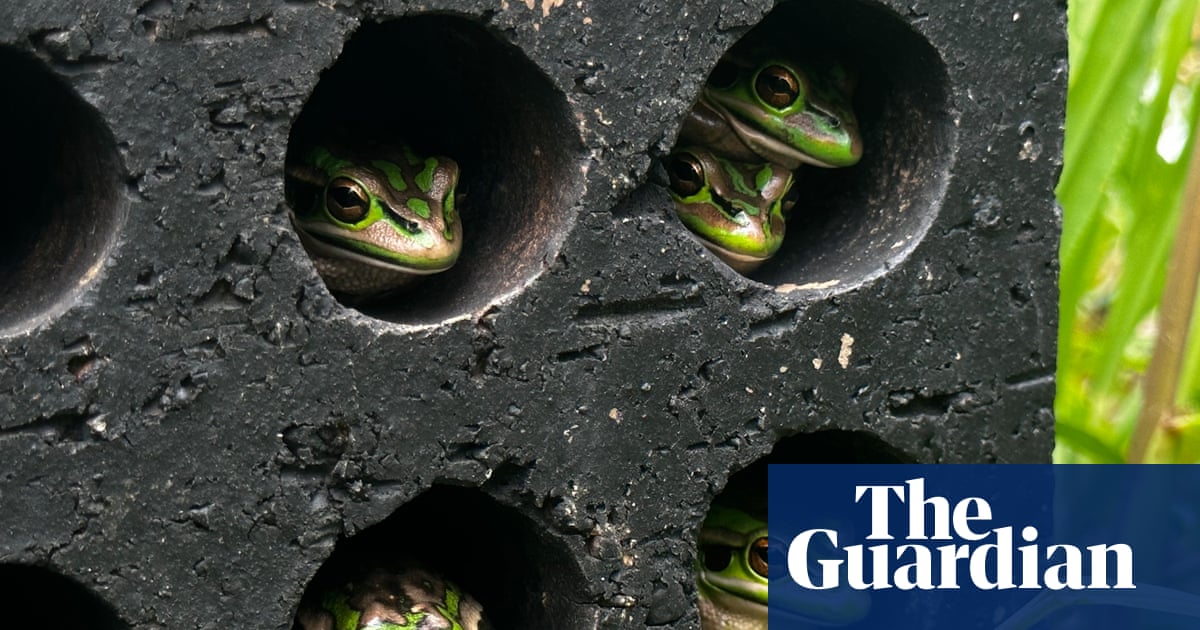A âsaunaâ treatment for frogs has been used by researchers in Australia to successfully fight a deadly fungal disease that has devastated amphibians around the world, according to a new study.
Scientists created refuges for the animals using painted masonry bricks inside greenhouses that they called âfrog saunasâ. They found that endangered Australian green and golden bell frogs were able to clear infections from the deadly Batrachochytrium dendrobatidis fungus, in the warmer conditions of the greenhouses, when they would otherwise have died. Many of the frogs that recovered in the refuges were then resistant to infection.
While the technique had previously been unsuccessful for other frog species, researchers found that the green and golden bell frog â once common in south-eastern Australia â responded well to the treatment, a discovery that offered hope for their future survival. Researchers said the rare amphibians were chosen after careful testing, which found they favoured the bricks as a habitat.
âWhy weâre so excited about [the studyâ] is there just hasnât been anything that works [to stop the infection],â said Dr Anthony Waddle, a postdoctoral researcher at Macquarie University in Sydney who led the study. âThe last line of defence is bringing the frogs into captivity where you can cure and protect them. Weâre slowly watching species blink out.â
In glacial ponds and alpine lakes, rainforests and wetlands, the deadly fungus has been killing off the wordâs amphibian populations. At least 90 species are known to have gone extinct and many more are expected to disappear in the coming years. Scientists say it is the greatest recorded loss of biodiversity attributable to a single disease.
The Tanzanian Kihansi spray toad, Honduran Cerro Búfalo streamside frog and Mexican claw-toothed salamander are among the species believed to have been wiped out by the infection in the wild.
Waddle said that while there were caveats to where the steam-room strategy could be used, it was a rare piece of good news for the green and golden bell frogs. âThis species is really limited to the coastal area of its former range. Ninety per cent of its populations have gone and more and more go every year. Theyâre not doing well. Theyâre not coming back. Theyâre not showing that clear sign of recovery that some other species have done on their own. So weâre excited,â he said.
The fungus, which is often known as Bd, causes a disease called chytridiomycosis in amphibians. It was formally identified by researchers in 1998 after widespread frog deaths around the world. The infection attacks the amphibiansâ skin, causing heart attacks and death. The most deadly strain of the disease appears to be about 100 years old and researchers think it was probably spread by humans.
Andrew Cunningham, the professor of wildlife epidemiology at the Zoological Society of Londonâs Institute of Zoology who first identified the fungal disease, said the technique had been tried with other species but there was no evidence it had worked for them.
âWeâve done this both through manipulating their natural environment to increase sun exposure and ground and water temperature, and by the installation of heated ponds (to a temperature above which the fungus cannot survive, but the frogs can). We have continued to have lethal outbreaks of chytridiomycosis and the only way to stop these has been to bring the frogs under human care to treat them with a fungicidal drug,â he said.
âMaybe the technique is species-specific, but unfortunately, I doubt it is a silver bullet for tackling the global threat of amphibian chytridiomycosis,â he added.
Find more age of extinction coverage here, and follow biodiversity reporters Phoebe Weston and Patrick Greenfield on X for all the latest news and features



